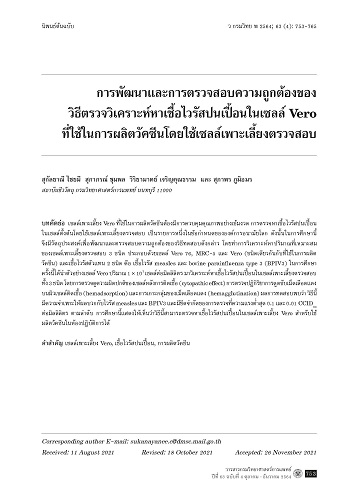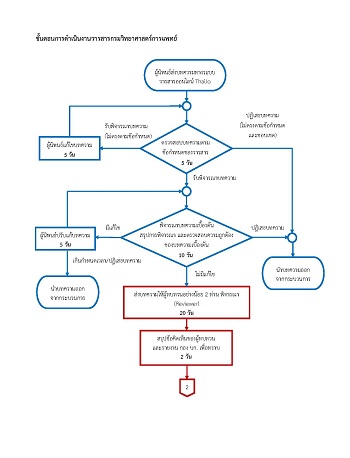การพัฒนาและการตรวจสอบความถูกต้องของวิธีตรวจวิเคราะห์หาเชื้อไวรัสปนเปื้อนในเซลล์ Vero ที่ใช้ในการผลิตวัคซีนโดยใช้เซลล์เพาะเลี้ยงตรวจสอบ
คำสำคัญ:
เซลล์เพาะเลี้ยง Vero, เชื้อไวรัสปนเปื้อน, การผลิตวัคซีนบทคัดย่อ
เซลล์เพาะเลี้ยง Vero ที่ใช้ในการผลิตวัคซีนต้องมีการควบคุมคุณภาพอย่างเข้มงวด การตรวจหาเชื้อไวรัสปนเปื้อนในเซลล์ตั้งต้นโดยใช้เซลล์เพาะเลี้ยงตรวจสอบ เป็นรายการหนึ่งในข้อกำหนดขององค์การอนามัยโลก ดังนั้นในการศึกษานี้จึงมีวัตถุประสงค์เพื่อพัฒนาและตรวจสอบความถูกต้องของวิธีทดสอบดังกล่าว โดยทำการวิเคราะห์หาปริมาณที่เหมาะสมของเซลล์เพาะเลี้ยงตรวจสอบ 3 ชนิด ประกอบด้วยเซลล์ Vero 76, MRC-5 และ Vero (ชนิดเดียวกันกับที่ใช้ในการผลิตวัคซีน) และเชื้อไวรัสตัวแทน 2 ชนิด คือ เชื้อไวรัส measles และ bovine parainfl uenza type 3 (BPIV3) ในการศึกษาครั้งนี้ได้นำตัวอย่างเซลล์ Vero ปริมาณ 1 × 107 เซลล์ต่อมิลลิลิตร มาวิเคราะห์หาเชื้อไวรัสปนเปื้อนในเซลล์เพาะเลี้ยงตรวจสอบทั้ง 3 ชนิด โดยการตรวจดูความผิดปกติของเซลล์หลังการติดเชื้อ (cytopathic effect) การตรวจปฏิกิริยาการดูดซับเม็ดเลือดแดงบนผิวเซลล์ติดเชื้อ (hemadsorption) และการเกาะกลุ่มของเม็ดเลือดแดง (hemagglutination) ผลการทดสอบพบว่า วิธีนี้มีความจำเพาะให้ผลบวกกับไวรัส measles และ BPIV3 และมีขีดจำกัดของการตรวจที่ความแรงต่ำสุด 0.1 และ 0.01 CCID50 ต่อมิลลิลิตร ตามลำดับ การศึกษานี้แสดงให้เห็นว่าวิธีนี้สามารถตรวจหาเชื้อไวรัสปนเปื้อนในเซลล์เพาะเลี้ยง Vero สำหรับใช้ผลิตวัคซีนในห้องปฏิบัติการได้
เอกสารอ้างอิง
Kiesslich S, Kamen AA. Vero cell upstream bioprocess development for the production of viral vectors and vaccines. Biotechnol Adv. [serial online]. 2020; [cited 2021 Oct 17]; 44: [9 screens]. Available from: URL: https://www.sciencedirect.com/science/article/pii/S0734975020301105?via%3Dihub.
Barrett PN, Mundt W, Kistner O, Howard MK. Vero cell platform in vaccine production: moving towards cell culture-based viral vaccines. Expert Rev Vaccines 2009; 8(5): 607-18.
World Health Organization. Recommendations for the evaluation of animal cell cultures as substrates for the manufacture of biological medicinal products and for the characterization of cell banks Annex 3, TRS No 978. [online]. 2013; [cited 2021 Mar 2]; [110 screens]. Available from: URL: https://www.who.int/publications/m/item/animal-cell-culture-trs-no-978-annex3.
Sadeghi M, Kapusinszky B, Yugo DM, Phan TG, Deng X, Kanevsky I, et al. Virome of US bovine calf serum. Biologicals 2017; 46: 64-7.
Marcus-Sekura C, Richardson JC, Harston RK, Sane N, Sheets RL. Evaluation of the human host range of bovine and porcine viruses that may contaminate bovine serum and porcine trypsin used in the manufacture of biological products. Biologicals 2011; 39(6): 359-69.
Schirtzinger EE, Suddith AW, Hause BM, Hesse RA. First identification of porcine parvovirus 6 in North America by viral metagenomic sequencing of serum from pigs infected with porcine reproductive and respiratory syndrome virus. Virol J. [serial online]. 2015; [cited 2021 Mar 2]; 12: [10 screens]. Available from: URl: https://www.ncbi.nlm.nih.gov/pmc/articles/PMC4609089/pdf/12985_2015_Article_401.pdf.
European Medicines Agency. Quality of biotechnological products: viral safety evaluation of biotechnology products derived from cell lines of human or animal origin, ICH Q5A (R1). [online]. 1997; [cited 2021 Oct 17]; [29 screens]. Available from: URL: https://www.ema.europa.eu/en/ichq5a-r1-quality-biotechnological-products-viral-safety-evaluation-biotechnology-products-derived.
Food and Drug Administration. Guidance for industry-Characterization and qualification of cell substrates and other biological materials used in the production of viral vaccines for infectious diseases indications. [online]. 2010; [cited 2021 Oct 17]; [50 screens]. Available from: URL: https://www.fda.gov/media/78428/download.
Gombold J, Karakasidis S, Niksa P, Podczasy J, Neumann K, Richardson J, et al. Systematic evaluation of in vitro and in vivo adventitious virus assays for the detection of viral contamination of cell banks and biological products. Vaccine 2014; 32(24): 2916-26.
Appendix 4 Analytical method validation. In: World Health Organization. Annex 4 Supplementary guidelines on good manufacturing practices: validation, TRS No. 937. Geneva: World Health Organization; 2006. p. 136-140.
European Medicines Agency. ICH harmonised tripartite guideline, Validation of analytical procedures: text and methodology Q2(R1). [online]. 2005 [cited 2021 Oct 17]; [17 screens]. Available from: URL: https://database.ich.org/sites/default/files/Q2%28R1%29%20Guideline.pdf.
Nims RW. Detection of adventitious viruses in biologicals--a rare occurrence. Dev Biol (Basel) 2006; 123: 153-64.
Matumoto M. Multiplication of measles virus in cell cultures. Bacteriol Rev 1966; 30(1): 152-76.
Morris C, Lee YS, Yoon S. Adventitious agent detection methods in bio-pharmaceutical applications with a focus on viruses, bacteria, and mycoplasma. Curr Opin Biotechnol 2021; 71: 105-14.
เซลล์เพาะเลี้ยง Vero สำหรับการผลิตวัคซีนใน: ระเบียบกรมวิทยาศาสตร์การแพทย์ว่าด้วยอัตราค่าบำรุงการตรวจวิเคราะห์และให้บริการ ฉบับที่ 6 (พ.ศ. 2564). ราชกิจจานุเบกษา เล่ม 138 ตอนพิเศษ 80 ง (วันที่ 9 เมษายน 2564). หน้า 10.

ดาวน์โหลด
เผยแพร่แล้ว
รูปแบบการอ้างอิง
ฉบับ
ประเภทบทความ
สัญญาอนุญาต
ลิขสิทธิ์ (c) 2021 วารสารกรมวิทยาศาสตร์การแพทย์

อนุญาตภายใต้เงื่อนไข Creative Commons Attribution-NonCommercial-NoDerivatives 4.0 International License.



